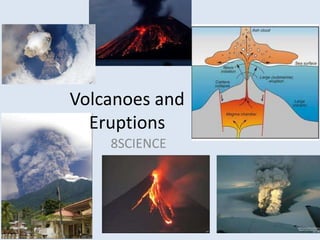Volcanoes and eruptions
•Descargar como PPTX, PDF•
2 recomendaciones•3,349 vistas
Denunciar
Compartir
Denunciar
Compartir

Recomendados
Más contenido relacionado
La actualidad más candente
La actualidad más candente (20)
Volcano Features, Earth Science Lesson PowerPoint, Buld a Volcano

Volcano Features, Earth Science Lesson PowerPoint, Buld a Volcano
Destacado
A presentation about how mental health and criminal justice policies and services are converging in the UK. The report on the subject is available from: http://www.centreformentalhealth.org.uk/publications/blurring_the_boundaries.aspx?ID=608
Originally uploaded 15 March 2010.Blurring the boundaries: the convergence of mental health and criminal justice

Blurring the boundaries: the convergence of mental health and criminal justiceCentre for Mental Health
Destacado (18)
Blurring the boundaries: the convergence of mental health and criminal justice

Blurring the boundaries: the convergence of mental health and criminal justice
Engineering Geology (Civil Engineering Applications)

Engineering Geology (Civil Engineering Applications)
Similar a Volcanoes and eruptions
Similar a Volcanoes and eruptions (20)
Más de amandayoung313
Más de amandayoung313 (20)
Volcanoes and eruptions
- 1. Volcanoes and Eruptions 8SCIENCE
- 2. Review Where do volcanoes form? Plate boundaries How do volcanoes form? Heat and pressure from inside the Earth produces magma and pushes up to the surface What is a hotspot? Very hot areas in the mantle that produce volcanoes although they are not found on plate boundaries
- 3. Types of Volcanoes Shield Cinder cone Composite
- 4. Shield volcanoes Quiet eruption that produces lava and spreads out in flat layers These layers build to form slightly sloping sides Ex: Hawaiian islands
- 5. Cinder cone volcano Explosive eruptions that throw lava and rocks high into the air These bits of rock and hardened lava are called tephra Tephra layers build up to form steep sided volcanoes
- 6. Composite volcano Produces eruptions that are quiet then violent Cycles of lava and tephra form different layers Usually found where one plate is forced under another
- 7. What causes an eruption to be quiet or violent? Amount of water vapor and other gases trapped in magma High gas content = more violent eruption Gases are trapped in magma and pressure builds up As magma moves closer to the surface, there is less pressure and the gas can escape Amount of silica (silicon and oxygen) present in magma Low in silica = more quiet eruption
- 8. Other volcanic structures Not all magma flows to the surface Some may rise from the volcano and cools underground to form other rock structures Erosion of the rock layers make these visible to us today
- 9. CALDERAS IN OREGON (US) AND PHILLIPINES DEATH VALLEY, CALIFORNIA SHIPROCK, NEW MEXICO COLOMBIA